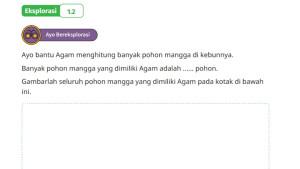Kunci Jawaban
Kunci Jawaban Bahasa Inggris Kelas 9 Semester 2 Chapter 8 Halaman 148: Traditional Foods
Mari simak berikut ini kunci jawaban Bahasa Inggris kelas 9 semester 2 chapter 8 halaman 148 bagian Observing & Asking Question: Tradition Foods.
TRIBUN-BALI.COM – Halo guys! yuk simaklah berikut ini kunci jawaban Bahasa Inggris kelas 9 semester 2 chapter 8 halaman 148 bagian Observing & Asking Question: Tradition Foods.
Kunci jawaban Bahasa Inggris kelas 9 semester 2 chapter 8 halaman 148 ini, sesuai dengan buku Bahasa Inggris kelas 9 semester 2 Kurikulum 2013 edisi revisi 2018 berjudul ‘Think Globally Act Locally’.
Soal Bahasa Inggris kelas 9 semester 2 halaman 148, para siswa disuruh untuk menyebutkan fakta-fakta dari makanan tradisional seperti sate, lemper, pempek, dan kerupuk.
Diharapkan, dengan adanya kunci jawaban Bahasa Inggris semester 2 kelas 9 soal halaman 148 ini, dapat membantu para siswa untuk memahami soal yang ada dan mengerjakannya dengan cepat.
Baca juga: Kunci Jawaban Bahasa Inggris Kelas 9 Hal 133: 12 Jawaban Tentang Kisah Sangkuriang & Dayang Sumbi
Baca juga: Kunci Jawaban Bahasa Inggris Kelas 7 Halaman 113: What do They Say about Their Pets?
Alangkah baiknya, siswa mengerjakan terlebih dahulu secara mandiri, sebelum melihat pada kunci jawaban yang disediakan.
Dilansir dari Tribunnews, berikut adalah kunci jawaban Bahasa Inggris kelas 9 semester 2 chapter 8 halaman 148 tentang Traditional Foods.
Kunci Jawaban Bahasa Inggris Kelas 9 Halaman 148
Observing & Asking Questions
We will list the facts about the traditional foods stated by Udin, Siti, Lina and Beni. We will list eight facts about satay, six facts about 'lemper', seven facts about 'pempek, and eight facts about 'kerupuk.
Here are what we will do. We will work in groups. First, we will study and copy the examples to our book. Second, we will read the descriptions carefully. Third, we will handwrite in our book the facts we find in the descriptions. Finally, we will underline the verb in every sentence.
We will make sure we know the meaning of every word. We will use a dictionary. We will spell the words and use the punctuation marks correctly. While we are writing, we will say the sentences loudly, clearly, and correctly. If we have any problems, we will go to our teacher for help.
1. Eight facts about satay stated by Udin.

- Satay or ‘sate’ is made of chicken, beef, or lamb.
- ‘Sate ayam’ is made of chicken.
- ‘Sate kambing’ is made of lamb.
- Some pieces of well marinated meat are skewered.
- ‘Sate sapi’ is made of beef.
- On skewers, satay is grilled over very hot charcoal.
- It is served with peanut sauce or soy sauce.
- Small pieces of meat are marinated in spicy soy sauce.
Baca juga: Kunci Jawaban Bahasa Inggris Kelas 7 Halaman 116: What Your Friends Say about These Animals?
2. Six facts about ‘lemper’ stated by Siti.

- ‘Lemper’ is made of a handful lump of steamed glutinous rice.
- If the glutinous rice is well-cooked before ‘lemper’ is filled and wrapped, it can be served straight away with the banana leaf still green and fresh.
- Each piece is wrapped in a banana leaf.
- It is filled with chicken or beef filling.
- ‘Lemper’ in the banana leaf is steamed, or cooked over a very hot barbecue or grill.
- The wrapping is secured on both ends with toothpicks or ‘lidi’.
3. Seven facts about ‘pempek’ stated by Lina:

- ‘Pempek’ is a very popular food from South of Sumatra.
- ‘Pempek’ is served with ‘cuko’.
- Cuko is made of brown sugar, chilly, garlic, tamarind, and salt.
- It is made of fish and tapioca starch.
Baca juga: Kunci Jawaban Bahasa Inggris Kelas 8 Halaman 89-90: Collect the Informations about These Animals
- Fish, tapioca starch, and water are mixed to make thick dough.
- In different shapes and sizes, the dough is boiled until it floats.
- The cooked ‘pempek’ is then deep-fried
4. Eight facts about ‘kerupuk’ stated by Beni.

- ‘Kerupuk’ is shaped in thin pieces.
- ‘Kerupuk’ are very crunchy crackers
- Very dry ‘kerupuk’ is deep-fried in hot cooking oil.
- The pieces of ‘kerupuk’ are dried under the sun until it is completely dry and hard.
- Different kinds of crackers are easily found everywhere in Indonesia.
- Some kinds of ‘kerupuk’ are fried in very hot sand.
- It is made of tapioca starch.
- It is flavoured with fish, shrimp, or garlic.
Demikian kunci jawaban Bahasa Inggris kelas 9 chapter 8 soal halaman 148 bagian Observing & Asking Question: Traditional Foods.
Baca juga: Kunci Jawaban Bahasa Inggris Kelas 8 Hal 88: Lets Translate this Text About Animals
*) Disclaimer:
- Jawaban di atas hanya digunakan oleh orangtua untuk memandu proses belajar anak.
- Soal ini berupa pertanyaan terbuka yang artinya ada beberapa jawaban tidak terpaku seperti di atas.
Artikel ini telah tayang di Tribunnews.com dengan judul Kunci Jawaban Bahasa Inggris Kelas 9 Halaman 148 Semester 2, Chapter 8: Traditional Foods. (*)
kunci jawaban
Kunci Jawaban Bahasa Inggris
Kunci Jawaban Bahasa Inggris Kelas 9
semester 2
Kurikulum 2013
Kunci Jawaban Bahasa Inggris Kelas 9 Halaman 148
Traditional Foods
| Kunci Jawaban Matematika Kelas 6 SD Kurikulum Merdeka Halaman 13, Eksplorasi 1.2: Pohon Mangga |

|
|---|
| Kunci Jawaban Matematika Kelas 6 SD Kurikulum Merdeka Halaman 12, Ayo Berpikir Kritis: Bilangan Asli |

|
|---|
| Kunci Jawaban Matematika Kelas 6 SD Kurikulum Merdeka Halaman 8 9, Eksplorasi 1.1: Kebun Agam |

|
|---|
| Kunci Jawaban Matematika Kelas 9 SMP Kurikulum Merdeka Halaman 69 70, Ayo Mencoba 2.8 |

|
|---|
| Kunci Jawaban Matematika Kelas 9 SMP Kurikulum Merdeka Halaman 67 68, Ayo Mencoba 2.7 |

|
|---|















Isi komentar sepenuhnya adalah tanggung jawab pengguna dan diatur dalam UU ITE.